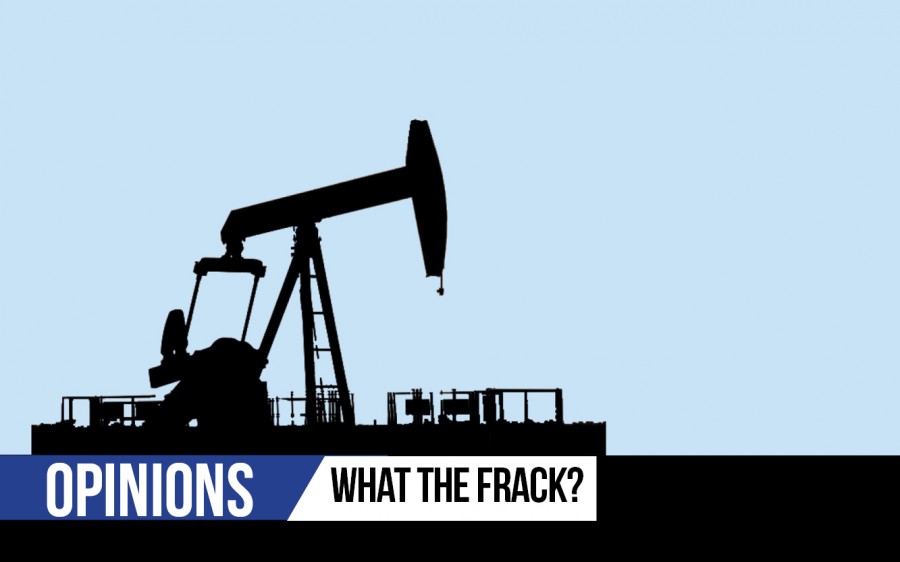What the Frack?
January 30, 2015
Last month, New York Governor Andrew Cuomo made headlines by suspending a process of drilling for natural gas called hydraulic fracking. Citing various studies that investigated the impact of fracking on the environment and its potential hazards to human health, he quickly called for a state-wide ban on the practice.
Fracking has made the news over the last few years due to the extreme nature of the process. Most wells drill down almost two miles–and in many cases also drill horizontally a few miles–and then inject pressurized water and chemicals to break up shale rock deposits that contain natural gas and oil. The process has exploded throughout the United States, notably in Midwestern states that are now reliant on the industry for jobs and economic growth.
A new study has been released by Duke University showing that two previously unknown by-products of drilling–ammonium and iodide, both known to be toxic to humans–are making their way into the waterways of Pennsylvania, Texas, and West Virginia. The team found ammonium levels in Pennsylvanian water to be “50 times higher than the Environmental Protection Agency’s water-quality threshold.” Despite this fact, wastewater from hydraulic fracking is not regulated by the Safe Drinking Water Act due to a loophole in the Energy Policy Act of 2005.
Among the findings are several old studies that find fracking to be similarly detrimental to humans. A 2014 report by Brown University found that women living near fracking sites have a 30 percent increased risk of giving birth to children with congenital heart defects. In a 2013 Colorado State study, it was discovered that fracking significantly increases upper respiratory issues and skin problems. A 2014 study in New York looked at emissions in five fracking states and found carcinogenic chemicals, such as benzene, to be as high as 770,000 times the natural level.
There have also been earthquake “swarms” over the last several years in Nevada, Texas, and Oklahoma, three other prominent fracking states. The U.S. Geologic Survey (USGS) stated that “the increase in seismic activity coincides with the injection of wastewater in deep disposal wells,” which is a byproduct of fracking where each well can generate up to four million gallons of wastewater. The USGS also stated that because earthquakes have “increased remarkably” in just the last year, Oklahoma should be preparing for a “damaging tremor,” which many of these smaller earthquakes often precede.
The cumulative effects of these studies greatly factored into Cuomo’s decision to put a statewide moratorium on fracking in New York. Despite evidence overwhelmingly pointing fracking in the direction of environmental destruction and increased health risks, it has become one of the fastest growing industries in the country. The country as a whole is sacrificing its citizens’ well being for marginal economic gain.
Pennsylvania is especially culpable in this current age of environmental destruction and endangerment–especially with regards to water regulation. Some states with longer drilling records dispose of the water through injecting it deep into underground wells. This method is supposedly “safe,” but it then becomes hard to track the water, making it almost certain that it will end up in bodies used for personal consumption or agriculture.
Similarly, the lack of national regulation means that the burden to oversee these wells rests on individual states. The lack of a history of oil and gas drilling coupled with an increasingly conservative government means that Pennsylvania severely lacks the necessary means to regulate the industry. Cabot Oil & Gas Corporation, a major driller in the state, has been cited 265 times for violations in the past three years, but this is only a fraction of the total number of claims against them.
Pennsylvania, a relative newcomer to the shale oil and gas boom, does not have the same sort of methods in place and disposes water into waterways that are cleaned at conventional treatment centers (which are not designed to remove many of these toxins from the water). The state government is also overwhelmingly supportive of the oil and gas industry due to the economic benefits it offers the state.
As residents of Pennsylvania, it is important to be aware of what is going on at the state and national level. The growing popularity of fracking has put tremendous pressure on already strained ecosystems and waterways. It should be disconcerting to see that the place that we call home for 270 days a year is one of the more environmentally unfriendly and egregiously polluted states.
When it comes to fracking, the question we must ask ourselves is what is the true cost to society? Sure, gas prices are cheap in the short run, but we are depleting the very small number of resources we have left and are allowing oil and gas bandits to ravish the physical landscape of this country with impunity. If the recent trend is to be reversed, it is our responsibility to understand the issue and take part in public discourse on the subject. Only then can we hope to have figures like Cuomo continue to lead the country down a sustainable path.
























